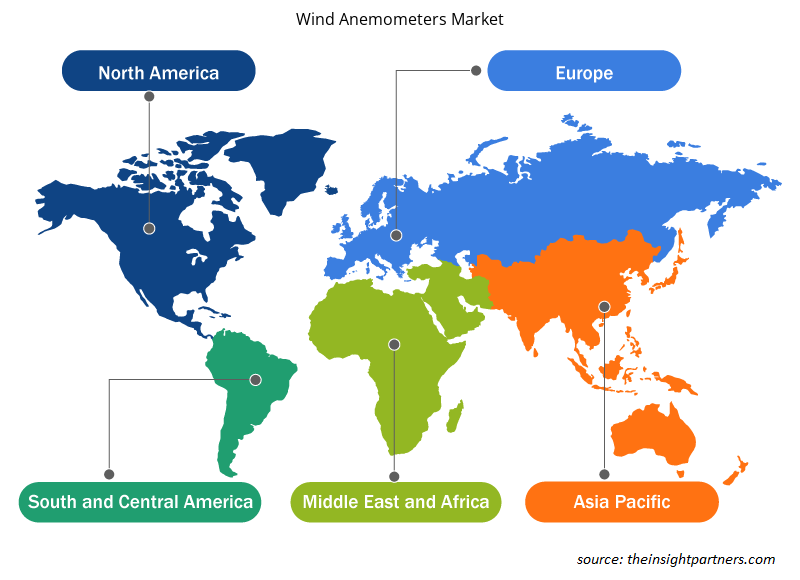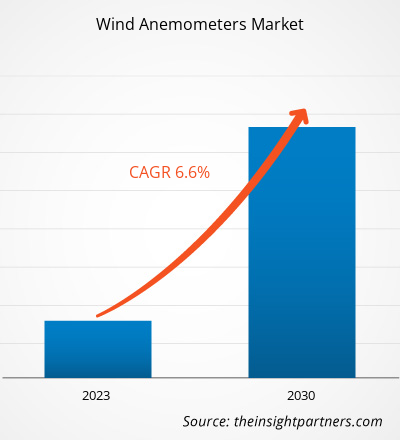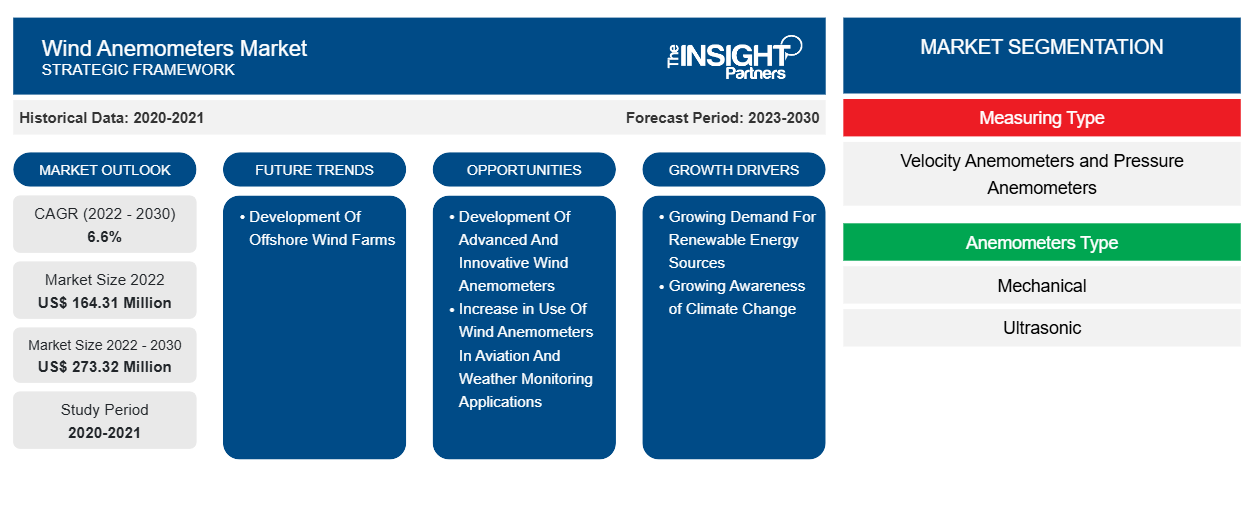[Informe de investigación] El tamaño del mercado de anemómetros de viento se valoró en US$ 164,31 millones en 2022 y se espera que alcance los US$ 273,32 millones para 2030. Se espera que el mercado de anemómetros de viento registre una CAGR del 6,6% entre 2022 y 2030.
Perspectiva del analista:
Los anemómetros se utilizan ampliamente en todas las estaciones meteorológicas, desde el gélido Ártico hasta las húmedas zonas ecuatoriales. La velocidad del viento ayuda a indicar un cambio en los patrones meteorológicos, por ejemplo, la proximidad de tormentas. Es importante para los climatólogos, ingenieros y pilotos. Varias empresas que operan en el mercado de los anemómetros de viento están lanzando nuevos dispositivos para medir el viento. Por ejemplo, en junio de 2023, el fabricante de sensores con sede en el Reino Unido Gill Instruments lanzó un nuevo anemómetro ultrasónico de doble eje (Windultra) para medir la dirección y la velocidad del viento. Está diseñado para su uso en diversas aplicaciones marinas o terrestres. Las características de rápida instalación y alineación de WindUltra incluyen una selección de montajes de dos postes, ya sea un montaje de poste con cierre giratorio de 1 pulgada (25-26 mm) o un montaje de poste con abrazadera de banda de 1,75-2 pulgadas (44-51 mm).
Descripción general del mercado de anemómetros de viento:
Un anemómetro de viento mide la velocidad del viento y su presión. Para estudiar los patrones climáticos, estos instrumentos son herramientas esenciales para los meteorólogos. Estos dispositivos son utilizados por los físicos mientras estudian los movimientos del aire. Diferentes empresas de fabricación en todo el mundo ofrecen varios instrumentos anemómetros en industrias como HVAC, marina, energía eólica, construcción y aeroespacial. Además, para la velocidad del aire o el viento, se utilizan diferentes tipos de anemómetros para la multifuncionalidad, incluida la temperatura y la humedad. Según el tipo, estos también poseen la funcionalidad de registro o grabación de datos para tomar dimensiones a largo plazo en un período determinado. Hay varios beneficios del anemómetro de viento, como alta precisión y bajo consumo de energía. Usando solo un solo dispositivo, el usuario puede medir múltiples parámetros como la velocidad, la velocidad, la dirección y la presión del viento.
Personalice este informe según sus necesidades
Obtendrá personalización en cualquier informe, sin cargo, incluidas partes de este informe o análisis a nivel de país, paquete de datos de Excel, así como también grandes ofertas y descuentos para empresas emergentes y universidades.
- Obtenga las principales tendencias clave del mercado de este informe.Esta muestra GRATUITA incluirá análisis de datos, desde tendencias del mercado hasta estimaciones y pronósticos.
Impulsor del mercado de anemómetros de viento:
La creciente demanda de fuentes de energía renovable impulsa el crecimiento del mercado de anemómetros eólicos
El crecimiento de las fuentes de energía renovables , en particular la energía eólica, impacta sustancialmente en el mercado de anemómetros eólicos. Según la Agencia Internacional de Energía (AIE), en 2022, el suministro de energía renovable proveniente de la energía eólica, solar, hidroeléctrica, geotérmica y oceánica aumentó cerca de un 8%, y la participación de estas tecnologías en el suministro total de energía global aumentó aproximadamente un 0,4%, alcanzando el 5,5%. Además, la cantidad de electricidad generada por el viento aumentó en 265 TWh (un aumento del 14%), el segundo mayor crecimiento de todas las tecnologías de generación de energía. La energía eólica siguió siendo la tecnología renovable líder, generando más de 2100 TWh en 2022.
Los gobiernos de varios países están tomando iniciativas para aumentar los parques eólicos, incluida la energía eólica. Por ejemplo, en mayo de 2023, ITOCHU Corporation anunció que ITOCHU y Hitachi Zosen Corporation han comenzado los preparativos para el desarrollo y la operación de un parque eólico terrestre en un área frente al Océano Pacífico en Rokkasho Village, Distrito de Kamikita, Prefectura de Aomori y, tras la incorporación de Mutsu Ogawara Wind Power LLC, produce la electricidad. El diseño y la construcción de este proyecto de parque eólico terrestre está previsto que comience en abril de 2026. De manera similar, en junio de 2023, se inauguró el parque eólico flotante más grande del mundo frente a la costa oeste de Noruega. Equinor, con 88 megavatios (MW) de capacidad, generará energía para abastecer a las plataformas de petróleo y gas cercanas. Las turbinas eólicas tienen características muy avanzadas para mantener la eficiencia y la seguridad. El anemómetro de viento mide constantemente la velocidad del viento y transfiere los datos al controlador de la turbina eólica, que controla el rotor a una velocidad segura. Los anemómetros de viento son instrumentos esenciales utilizados en la industria de la energía eólica. Por lo tanto, las crecientes fuentes de energía renovable impulsarán aún más el crecimiento del mercado de anemómetros eólicos.
Análisis segmentario del mercado de anemómetros de viento:
Según el tipo de anemómetro, el mercado de anemómetros de viento se segmenta en mecánicos, ultrasónicos y otros. El segmento mecánico tuvo la mayor participación en el mercado de anemómetros de viento en 2022. Se espera que el segmento ultrasónico registre la CAGR más alta en el mercado de anemómetros de viento. Un anemómetro mecánico contiene una rueda con una hélice o copas en el extremo de los radios de la rueda. Una de las copas contiene un imán; cada vez que el imán pasa por un interruptor, realiza una grabación. La grabación del anemómetro mecánico proporciona una lectura extremadamente precisa de la velocidad del viento. Los tipos de anemómetros mecánicos son anemómetros de copa, anemómetros de paletas y otros. Un anemómetro de copa consta de cuatro copas hemisféricas unidas a un extremo de los brazos horizontales en ángulos iguales sobre un eje vertical. La posición de las copas es tal que el aire pasa a través de ellas en dirección horizontal, lo que hace que la rotación de la copa sea proporcional a la velocidad del viento. Varias escuelas en varios países están montando instrumentos para estaciones meteorológicas diseñadas según los estándares establecidos por el Departamento Meteorológico de la India (IMD).
Análisis regional del mercado de anemómetros de viento:
El tamaño del mercado de anemómetros eólicos de América del Norte se valoró en 59,65 millones de dólares estadounidenses en 2022 y se proyecta que alcance los 102,06 millones de dólares estadounidenses en 2030; se espera que registre una CAGR del 6,9% entre 2022 y 2030. El mercado de anemómetros eólicos de América del Norte está segmentado en Estados Unidos, Canadá y México. Estados Unidos tuvo la mayor participación del mercado de anemómetros eólicos en América del Norte en 2022. Las fuentes de energía renovables en Estados Unidos están aumentando significativamente. Según los Regentes de la Universidad de Michigan, la industria eólica estadounidense instaló 13.413 megavatios (MW) de nueva capacidad eólica en 2021, lo que eleva el total acumulado a 135.886 MW. Esta es la segunda capacidad eólica más alta instalada en un año, lo que representa una inversión de 20.000 millones de dólares estadounidenses. La energía eólica proporciona más del 9 % de la electricidad en todo el país, más del 50 % en Dakota del Sur y Iowa, y más del 30 % en Oklahoma, Kansas y Dakota del Norte. En 2022, las fuentes de energía renovable representaron aproximadamente el 13,1 % del consumo de energía primaria de EE. UU. Las fuentes de energía renovable representaron aproximadamente el 21,5 % de la generación total de electricidad a escala de servicios públicos. Los anemómetros eólicos se utilizan ampliamente para medir la velocidad del viento y transmitir datos de velocidad del viento al controlador. Por lo tanto, con el aumento de las fuentes de energía renovable, la demanda de anemómetros eólicos está aumentando significativamente en el país.
Análisis de los actores clave del mercado de anemómetros de viento:
LSI LASTEM Srl, Campbell Scientific Inc, Vaisala Oyj, RM Young Co, OTT HydroMet Fellbach GmbH, Gill Instruments Ltd, Adolf Thies GmbH & Co KG, Theta Instruments Co Ltd, Lambrecht meteo GmbH, Bristol Industrial & Research Associates Ltd y METEK Meteorologische Messtechnik GmbH se encuentran entre los actores clave que operan en el mercado de anemómetros de viento.
Perspectivas regionales del mercado de anemómetros de viento
Los analistas de Insight Partners explicaron en detalle las tendencias y los factores regionales que influyen en el mercado de anemómetros de viento durante el período de pronóstico. Esta sección también analiza los segmentos y la geografía del mercado de anemómetros de viento en América del Norte, Europa, Asia Pacífico, Oriente Medio y África, y América del Sur y Central.

- Obtenga datos regionales específicos para el mercado de anemómetros de viento
Alcance del informe de mercado de anemómetros de viento
| Atributo del informe | Detalles |
|---|---|
| Tamaño del mercado en 2022 | US$ 164,31 millones |
| Tamaño del mercado en 2030 | US$ 273,32 millones |
| CAGR global (2022-2030) | 6,6% |
| Datos históricos | 2020-2021 |
| Período de pronóstico | 2023-2030 |
| Segmentos cubiertos | Por tipo de medición
|
| Regiones y países cubiertos | América del norte
|
| Líderes del mercado y perfiles de empresas clave |
|
Densidad de actores del mercado de anemómetros de viento: comprensión de su impacto en la dinámica empresarial
El mercado de anemómetros de viento está creciendo rápidamente, impulsado por la creciente demanda de los usuarios finales debido a factores como la evolución de las preferencias de los consumidores, los avances tecnológicos y una mayor conciencia de los beneficios del producto. A medida que aumenta la demanda, las empresas amplían sus ofertas, innovan para satisfacer las necesidades de los consumidores y aprovechan las tendencias emergentes, lo que impulsa aún más el crecimiento del mercado.
La densidad de actores del mercado se refiere a la distribución de las empresas o firmas que operan dentro de un mercado o industria en particular. Indica cuántos competidores (actores del mercado) están presentes en un espacio de mercado determinado en relación con su tamaño o valor total de mercado.
Las principales empresas que operan en el mercado de anemómetros de viento son:
- LSI LASTEM Srl
- Vaisala Oyj
- Compañía RM Young
- Instrumentos Gill Ltd.
- Adolf Thies GmbH & Co. KG (Adolfo Thies)
Descargo de responsabilidad : Las empresas enumeradas anteriormente no están clasificadas en ningún orden particular.

- Obtenga una descripción general de los principales actores clave del mercado de anemómetros de viento
Desarrollos recientes:
Las estrategias inorgánicas y orgánicas, como las fusiones y adquisiciones, son ampliamente adoptadas por las empresas del mercado de anemómetros eólicos. A continuación, se enumeran algunos de los desarrollos más recientes del mercado de anemómetros eólicos:
- En 2023, Gill Instruments Ltd presentó WindUltra, un anemómetro de dos ejes. El producto ofrece un alto rendimiento combinado con robustez, diseño compacto y funciones de instalación y alineación rápidas, al tiempo que ofrece la detección ultrasónica de alta precisión de la velocidad y la dirección del viento por la que Gill es reconocido.
- En 2022, METEK adquirió áreas de negocio de Theodor Friedrichs GmbH & Co. Los productos de Theodor Friedrichs GmbH & Co. incluyen tecnología de sensores convencionales, el registrador de datos ampliamente utilizado tipo Combilog y una variedad de cámaras de prueba.
- Análisis histórico (2 años), año base, pronóstico (7 años) con CAGR
- Análisis PEST y FODA
- Tamaño del mercado, valor/volumen: global, regional y nacional
- Industria y panorama competitivo
- Conjunto de datos de Excel
Informes recientes
Informes relacionados
Testimonios
Razón para comprar
- Toma de decisiones informada
- Comprensión de la dinámica del mercado
- Análisis competitivo
- Información sobre clientes
- Pronósticos del mercado
- Mitigación de riesgos
- Planificación estratégica
- Justificación de la inversión
- Identificación de mercados emergentes
- Mejora de las estrategias de marketing
- Impulso de la eficiencia operativa
- Alineación con las tendencias regulatorias























 Obtenga una muestra gratuita para - Mercado de anemómetros de viento
Obtenga una muestra gratuita para - Mercado de anemómetros de viento